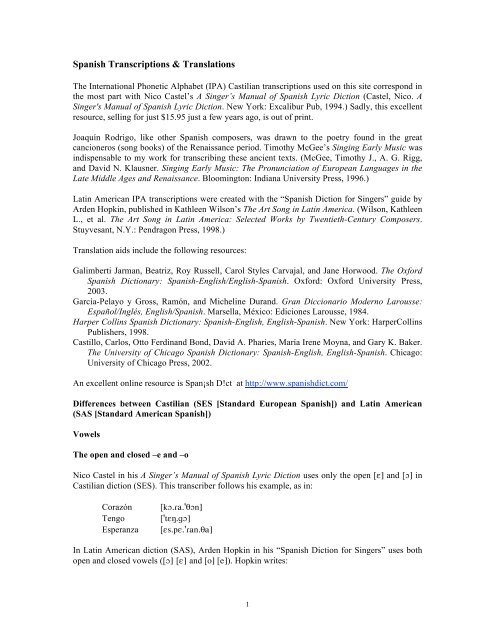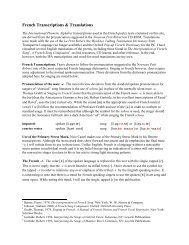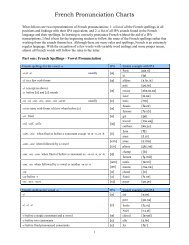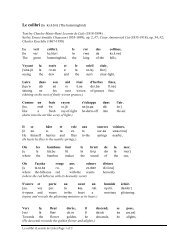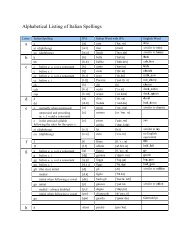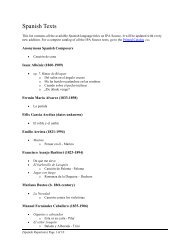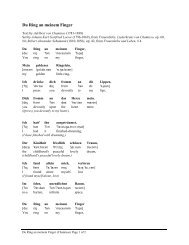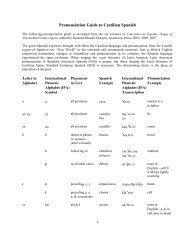1 Spanish Transcriptions & Translations - IPA Source
1 Spanish Transcriptions & Translations - IPA Source
1 Spanish Transcriptions & Translations - IPA Source
Create successful ePaper yourself
Turn your PDF publications into a flip-book with our unique Google optimized e-Paper software.
<strong>Spanish</strong> <strong>Transcriptions</strong> & <strong>Translations</strong><br />
The International Phonetic Alphabet (<strong>IPA</strong>) Castilian transcriptions used on this site correspond in<br />
the most part with Nico Castel’s A Singer’s Manual of <strong>Spanish</strong> Lyric Diction (Castel, Nico. A<br />
Singer's Manual of <strong>Spanish</strong> Lyric Diction. New York: Excalibur Pub, 1994.) Sadly, this excellent<br />
resource, selling for just $15.95 just a few years ago, is out of print.<br />
Joaquín Rodrigo, like other <strong>Spanish</strong> composers, was drawn to the poetry found in the great<br />
cancioneros (song books) of the Renaissance period. Timothy McGee’s Singing Early Music was<br />
indispensable to my work for transcribing these ancient texts. (McGee, Timothy J., A. G. Rigg,<br />
and David N. Klausner. Singing Early Music: The Pronunciation of European Languages in the<br />
Late Middle Ages and Renaissance. Bloomington: Indiana University Press, 1996.)<br />
Latin American <strong>IPA</strong> transcriptions were created with the “<strong>Spanish</strong> Diction for Singers” guide by<br />
Arden Hopkin, published in Kathleen Wilson’s The Art Song in Latin America. (Wilson, Kathleen<br />
L., et al. The Art Song in Latin America: Selected Works by Twentieth-Century Composers.<br />
Stuyvesant, N.Y.: Pendragon Press, 1998.)<br />
Translation aids include the following resources:<br />
Galimberti Jarman, Beatriz, Roy Russell, Carol Styles Carvajal, and Jane Horwood. The Oxford<br />
<strong>Spanish</strong> Dictionary: <strong>Spanish</strong>-English/English-<strong>Spanish</strong>. Oxford: Oxford University Press,<br />
2003.<br />
García-Pelayo y Gross, Ramón, and Micheline Durand. Gran Diccionario Moderno Larousse:<br />
Español/Inglés, English/<strong>Spanish</strong>. Marsella, México: Ediciones Larousse, 1984.<br />
Harper Collins <strong>Spanish</strong> Dictionary: <strong>Spanish</strong>-English, English-<strong>Spanish</strong>. New York: HarperCollins<br />
Publishers, 1998.<br />
Castillo, Carlos, Otto Ferdinand Bond, David A. Pharies, María Irene Moyna, and Gary K. Baker.<br />
The University of Chicago <strong>Spanish</strong> Dictionary: <strong>Spanish</strong>-English, English-<strong>Spanish</strong>. Chicago:<br />
University of Chicago Press, 2002.<br />
An excellent online resource is Span¡sh D!ct at http://www.spanishdict.com/<br />
Differences between Castilian (SES [Standard European <strong>Spanish</strong>]) and Latin American<br />
(SAS [Standard American <strong>Spanish</strong>])<br />
Vowels<br />
The open and closed –e and –o<br />
Nico Castel in his A Singer’s Manual of <strong>Spanish</strong> Lyric Diction uses only the open [”] and [O] in<br />
Castilian diction (SES). This transcriber follows his example, as in:<br />
Corazón<br />
Tengo<br />
Esperanza<br />
[kO.|a.'TOn]<br />
['t”N.gO]<br />
[”s.p”.'|an.Ta]<br />
In Latin American diction (SAS), Arden Hopkin in his “<strong>Spanish</strong> Diction for Singers” uses both<br />
open and closed vowels ([O] [”] and [o] [e]). Hopkin writes:<br />
1
A(n) open syllable ends in a vowel, while a closed syllable ends in a consonant.<br />
The distinction between open and closed may affect the pronunciation of the e<br />
and o vowels in such syllables…<br />
…In open syllables, use the long e [e]; in closed syllables, use the short e [”].<br />
In open syllables, use the long o closed [o]; in closed syllables, use the short o<br />
[O]… (p.10)<br />
…[e] and [o] are used “in all open syllables except when the e or o combines<br />
with a trilled r. These vowels also occur in closed syllables ending in d, m, n, or<br />
s… (p. 12, 13)<br />
Corazón<br />
Tengo<br />
Esperanza<br />
[ko.|a.'son]<br />
['teN.go]<br />
[es.pe.'|an.sa]<br />
Other vowels<br />
[a], [i], and [u] are pronounced similarly in SAS and SES.<br />
Consonant differences between Castilian and Latin American <strong>Spanish</strong><br />
Ceceo and Seceo<br />
When Castilian <strong>Spanish</strong> left the motherland for the “New World,” some pronunciation changes<br />
evolved just as British English underwent changes in the American and Australian colonies.<br />
Ceceo [T”.'T”.O] (the soft lisping sound associated with SES), for example, occurs when c is<br />
followed by e or i as in gracias ['g|a.Tjas]. Also in SES, the letter z, except when followed by a<br />
voiced consonant in a word or word group, is also pronounced as [T] as in zapato [Ta.'pa.tO].<br />
In SAS, seseo [se.'se.o] is the standard pronunciation as in gracias ['g|a.sjas]. The letter z is<br />
always voiceless [s] as in zapato [sa.'pa.to].<br />
Lleísmo and yeísmo<br />
Lleísmo [¥”.'iz.mO] and yeísmo [dZe.'iz.mo] refer to the pronunciation of the digram ll (the elye)<br />
in <strong>Spanish</strong> in words such as llama or llorar. In SES lleísmo, the digram ll is pronounced as [¥], as<br />
in yes.<br />
Llama ['¥a.ma] <br />
Llorar [¥O.'|ar] <br />
<br />
A minority of transcribers use [lj] for this symbol. Joan Wall in Diction for Singers (Wall, Joan.<br />
Diction for Singers: A Concise Reference for English, Italian, Latin, German, French, and<br />
<strong>Spanish</strong> Pronunciation. Dallas: Pst, 1990.) states that both [¥] and [j] are acceptable<br />
pronunciations. (p. 242)<br />
<br />
2
In SAS, an initial ll is pronounced as [dZ] as in gentle. If initial in a word group, the pronunciation<br />
is: <br />
Llama<br />
Llorar<br />
['dZa.ma] <br />
[dZO.'|ar] <br />
Within a word or word group, this double consonant in SAS is transcribed as [Ô] and is<br />
pronounced with a slightly more tensed tongue than [¥]. The pronunciation is: <br />
<br />
Llama ['Ôa.ma] <br />
Llorar [ÔO.'|ar] <br />
<br />
Other differences in SAS and SES<br />
SES<br />
SAS<br />
c before e, i [T] (thank) [s] (certain)<br />
g before e, i [x] (Bach) [C] (huge)<br />
j [x] (Bach) [C] (huge) before e, i<br />
[x] (Bach) before a, o, u<br />
ll [¥] (yes) always [dZ] (gentle) at beginning of phrase<br />
[Ô] (slightly more tense than [¥]) within<br />
a phrase<br />
n + f [M] (similar to sing [nf] as in enfant<br />
with m, not n)<br />
y if initial [j] (yes) [dZ] (gentle)<br />
y if interior [j] (yes) [Ô] (slightly more tense than [¥])<br />
y + n, l [dZ] (gentle) [dZ] (gentle)<br />
y as a conjunction [i] [i]<br />
y as a glide [j] [j]<br />
z if initial [T] (thank) [s] (cent)<br />
z if interior or final [T] (thank) [s] (cent)<br />
z + voiced consonant [z] (ease) [s] (cent)<br />
Other considerations<br />
Ladino, the fossilized language of the Sephardic Jews forced into exile from Spain in the late<br />
fifteenth century, maintains the soft interior consonants of [B], [D], and [ø]. The letters c and g<br />
before e and i are always [s] and [dZ] respectively. The letter j is pronounced [dZ]. The double<br />
consonant ll is pronounced [j], as in some parts of South America. The letter s is always voiced<br />
[z] except when initial in a word group. The letter z is [z], never [T]. The letter x is always [S] and,<br />
unlike SES, the letter v is always [v], never [B].<br />
3
Differences in <strong>Spanish</strong> pronunciation in North and South America, the Caribbean islands, and<br />
Central America are not included here as these differences are outside the scope of this project.<br />
Just as there are many dialects spoken in peninsular Spain, there are many more grammatical and<br />
pronunciation variables in the vast land masses of Latin America.<br />
Vernacular pronunciation, an entirely different issue, is generally avoided in art song repertoire.<br />
(Literal translation and <strong>IPA</strong> transcription © by Suzanne Rhodes Draayer—<strong>IPA</strong> <strong>Source</strong>, LLC)<br />
4


